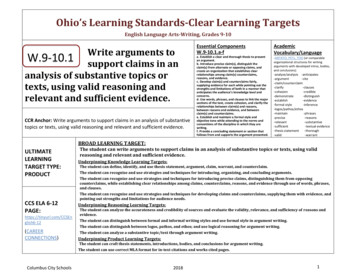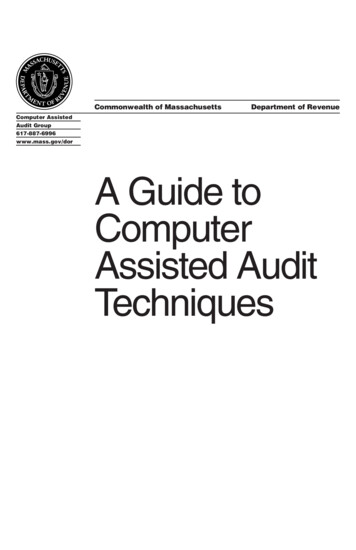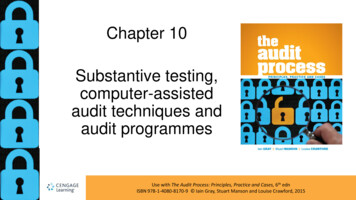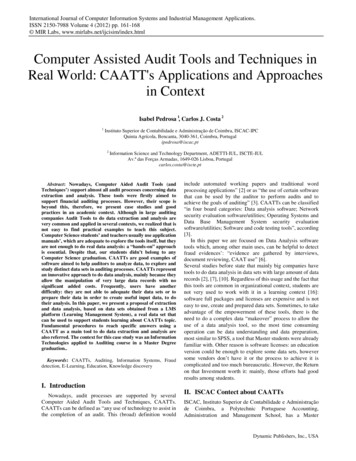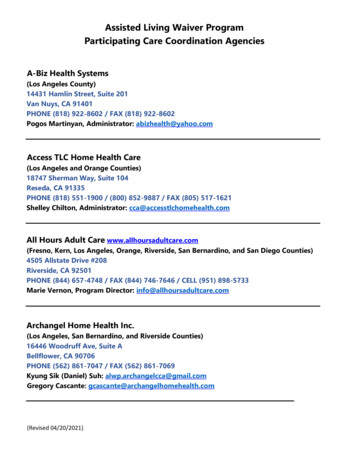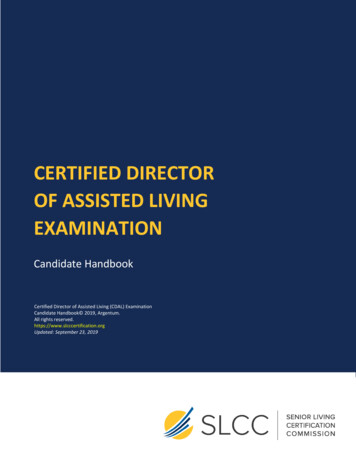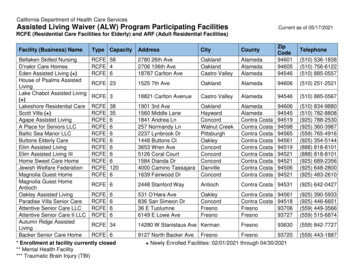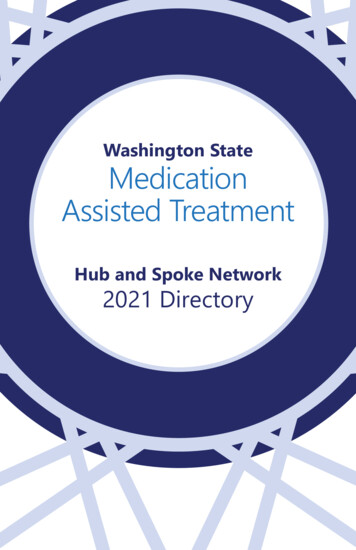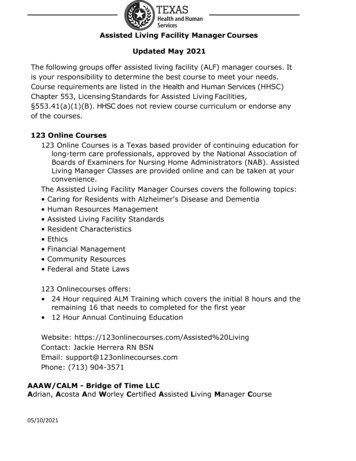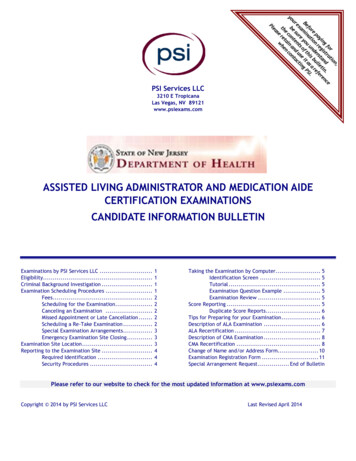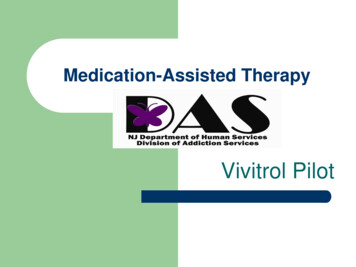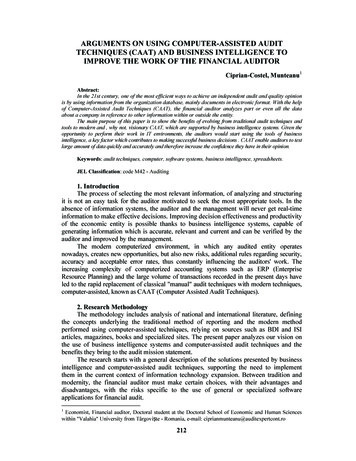
Transcription
ARGUMENTS ON USING COMPUTER-ASSISTED AUDITTECHNIQUES (CAAT) AND BUSINESS INTELLIGENCE TOIMPROVE THE WORK OF THE FINANCIAL AUDITORCiprian-Costel, Munteanu1Abstract:In the 21st century, one of the most efficient ways to achieve an independent audit and quality opinionis by using information from the organization database, mainly documents in electronic format. With the helpof Computer-Assisted Audit Techniques (CAAT), the financial auditor analyzes part or even all the dataabout a company in reference to other information within or outside the entity.The main purpose of this paper is to show the benefits of evolving from traditional audit techniques andtools to modern and , why not, visionary CAAT, which are supported by business intelligence systems. Given theopportunity to perform their work in IT environments, the auditors would start using the tools of businessintelligence, a key factor which contributes to making successful business decisions . CAAT enable auditors to testlarge amount of data quickly and accurately and therefore increase the confidence they have in their opinion.Keywords: audit techniques, computer, software systems, business intelligence, spreadsheets.JEL Classification: code M42 - Auditing1. IntroductionThe process of selecting the most relevant information, of analyzing and structuringit is not an easy task for the auditor motivated to seek the most appropriate tools. In theabsence of information systems, the auditor and the management will never get real-timeinformation to make effective decisions. Improving decision effectiveness and productivityof the economic entity is possible thanks to business intelligence systems, capable ofgenerating information which is accurate, relevant and current and can be verified by theauditor and improved by the management.The modern computerized environment, in which any audited entity operatesnowadays, creates new opportunities, but also new risks, additional rules regarding security,accuracy and acceptable error rates, thus constantly influencing the auditors' work. Theincreasing complexity of computerized accounting systems such as ERP (EnterpriseResource Planning) and the large volume of transactions recorded in the present days haveled to the rapid replacement of classical "manual" audit techniques with modern techniques,computer-assisted, known as CAAT (Computer Assisted Audit Techniques).2. Research MethodologyThe methodology includes analysis of national and international literature, definingthe concepts underlying the traditional method of reporting and the modern methodperformed using computer-assisted techniques, relying on sources such as BDI and ISIarticles, magazines, books and specialized sites. The present paper analyzes our vision onthe use of business intelligence systems and computer-assisted audit techniques and thebenefits they bring to the audit mission statement.The research starts with a general description of the solutions presented by businessintelligence and computer-assisted audit techniques, supporting the need to implementthem in the current context of information technology expansion. Between tradition andmodernity, the financial auditor must make certain choices, with their advantages anddisadvantages, with the risks specific to the use of general or specialized softwareapplications for financial audit.1Economist, Financial auditor, Doctoral student at the Doctoral School of Economic and Human Scienceswithin "Valahia" University from Târgoviște - Romania, e-mail: ciprianmunteanu@auditexpertcont.ro212
Finally, the article presents a practical application of the use of computer-assistedaudit techniques, specifically spreadsheets, in the audit tests performed on a case study.3. Challenges of the 21st Century for the Financial AuditorToday, in a computerized era, the need arises for the auditor to express an opinionbased on real-time information, instead of the classical historical approach. The auditorneeds to consider qualitative information produced by information systems, as pressurescome, in this respect, both from the internal management and the external shareholders,who need to be informed to withstand competition.As business intelligence systems are increasingly used by economic entities, theauditors' interest in them increases as well, along with the need to identify and understandall transactions and practices recorded by the computerized system, which, according to theauditor's judgment, may be significant for the financial statements. In general, businessintelligence refers to software designed to assist managerial decision through a system ableto manage the information available in an organization.Auditing Practice Regulation 1009 "Computer-Assisted Audit Techniques" isdeveloped based on the International Auditing Practice Regulation IASP - "ComputerAssisted Audit Techniques") approved by the International Federation of Accountants(IFAC) in the 2001 edition.Computer-assisted audit techniques can be defined as a computer-basedinstruments designed to improve the efficiency and performance of the audit process and itis a growing field in the 21st century. These techniques include basic office software,spreadsheets and word processors, as well as advanced software programs including smarttools for business, able to perform statistical analysis, in parallel with the development ofspecialized audit software programs.CAAT is an important step ahead from the analysis of financial statements andcustomer confirmation procedures, as this classical techniques are based on a small part ofthe transactions and may not always reflect the real situation of the entity in the auditedperiod, despite the auditors' efforts and professionalism. Using computerized applications,the auditors develop a clearer picture of the customer's "business" as they are able to verifylarge volumes of data, classify them according to certain criteria, they may issue statisticsand even forecasts, being provided with a complex picture of the audited company.In general terms, computer-assisted audit techniques refer to any computer programused to improve the auditing process. Specifically, it refers to software for extracting andanalyzing data, containing spreadsheets (eg. Excel), databases (eg. Access), statisticalanalysis (eg. SAS), etc.The advantages of audit software include: independence from the audited systemusing a read-only copy that cannot be influenced, the use of specific auditing methods suchas sampling, the production of specific documents for every test performed by the softwarethat may be included in the auditor's worksheets.Specialized audit software can perform the following: questionnaires, datastratification, simple extractions, identifying missing sequences, statistical analysis,calculations, identifying duplicate transactions, creating pivot tables and cross tabulation.Other uses of computer-assisted audit techniques include:- the ability to create electronic worksheets on a centralized database, inside whichthe auditor may coordinate current audits and can access information from past or similarprojects. In addition, the auditor will use a standardized audit report format, whichimproves the quality of the worksheets;- the possibility to detect fraud through the use of tools that can identify unexpectedor unexplained patterns in the audited data. No matter how simple or complicated the213
computer techniques used, cumputerized data analysis provides many benefits in theprevention and detection of fraud.- continuous monitoring as a constant process of accumulating, analyzing and reportingcompany data in order to identify business operational risk. Auditors are provided with acomprehensive data system as long as they make sure that the management continuouslymonitors activities on all computer systems, on all transactions and applications used.4. The Advantages of Using Computer-Assisted Audit TechniquesWhen using computer-assisted audit techniques, the auditor discovers that work isimproved and made more efficient, as it benefits from many advantages compared to thetraditional verification system. Among the advantages of using these techniques, we include:- testing the client's accounting software, as the auditor can verify whether it workscorrectly or not, since the volume of transactions subject to auditing is extremely high. Theonly effective way to test the client's program is by using computer-assisted techniques.- testing of large volumes of data in a short time and with good accuracy, so that theauditor has more confidence in his opinion.- testing the data source, as the auditor can test the accounting program and itsrecords directly at their origin, rather than testing paper documents that are supposed to beaccurate replicas.- cost effectiveness because, once an audit software is implemented, it can be usedyear after year to obtain audit evidence, provided the client does not regularly change theiraccounting software.- making comparisons between the results obtained using computer-assistedtechniques and the results of traditional tests. If similar results are obtained, the auditor'sgeneral confidence will grow.On the other hand, the auditor is not the only one to benefit from these advantages.The audited entity also acquires more certainty regarding the accuracy of the transactionsand the extent to which they comply with existing policies. By constant use of automatictransaction analysis and through continuous monitoring, these techniques allow testing andvalidating of critical company data, independently and in real time.The management of the audited entity may use this information to proactivelyidentify exceptions and take immediate action to meet standards, while the implementationof these programs help increase confidence in the data underlying the financial statements.5. Analyzing Specific RisksWhen auditors choose their work tools, they should evaluate the followingcharacteristics: ease of use, ease of data retrieval, the ability to access a wide range of datafiles on different platforms, the ability to integrate data in a different format, the ability todefine fields and select from standard formats, menu functionality to process analysisorders, setup and changes of simplified questionnaires.The traditional auditing method allows auditors to reach a reasonable conclusionbased on a limited sample of a population, but does not allow exhaustive examination of asample or of all available data. Using small samples can decrease efficiency of the finalconclusions, but the auditor states that sample selection is based on generally acceptedauditing standards and then the sample is statistically valid.Computer-assisted audit techniques solve this problem as they are able to analyzelarge volumes of data to identify errors. An audit based on these techniques will notexamine a sample, but all transactions of the audited entity in the period under audit. Thenthe auditor tests the data to identify possible anomalies - for example you can find VATregistration codes wrongly recorded by connecting your system to the national database or214
erroneously duplicated transactions by using spreadsheets. Identifying these potentialproblems, the auditor can address the management stating that 100% of transactions havebeen tested and 100% of anomalies have been identified.Another great advantage of computer-assisted audit techniques is allowing to test specificrisks. For example, when the auditor must verify issued invoices: the traditional method allows theauditor to randomly select a "statistically valid" sample of 100 invoices from various moments ofthe audited period. Since the total number of invoices may exceed 3,000, chances are very small todetect all possible errors in the selected sample. Instead, using computer-assisted techniques, theauditor can check all 3,000 invoices and will surely identify all existing errors.What do you prefer to say in an audit report? That "the auditor reviewed 100 invoicesand identified 5 invoices incorrectly recorded" or that "the auditor used computer-assistedtechniques to review all invoices from the audited period, identifying 78 erroneous records"?However, we must stress that the analysis using these techniques is limited to datastored on a systematic pattern. Unfortunately, few data is recorded in this manner and theavailable database usually lacks information or is incompletely classified, may be difficultto access or data integrity is doubtable. Therefore computer-assisted audit techniques arecurrently used along with the other traditional techniques and instruments. There are auditsin which computer-assisted techniques cannot be used at all, as well as audits which cannotbe performed efficiently and relevantly without these techniques.6. Specialized Audit SoftwareThere are already different kinds of computer audit programs, such as special packagesoftware, to be adapted to each case by changing the file format to be querried, by indicating therequired parameters and the shape of the desired result. In addition, the auditor may also useother available programs, designed for a specific purpose, special programs in which it is notpossible to adapt a software package because of the computer, of the processing method or of theway the chosen files are organized. And last but not least, we have access to the usual softwareused by the client to process data, such as Excel, for sorting and printing files.The Institute of Internal Auditors (IIA) conducted an analysis of audit software andissued several key recommendations for the auditor in selecting appropriate tools forcomputer-assisted techniques:1. establishing the mission statement, the objectives and priorities of the audit of anentity: the auditor should consult management about key priorities of the mission statementand the way to apply computer-assisted audit tools to perform this task more efficiently.2. determining the audit type and extent: what is the
intelligence refers to software designed to assist managerial decision through a system able to manage the information available in an organization. Auditing Practice Regulation 1009 "Computer-Assisted Audit Techniques" is developed based on the International Auditing Practice Regulation IASP - "Computer-Assisted Audit Techniques") approved by the International Federation of Accountants
